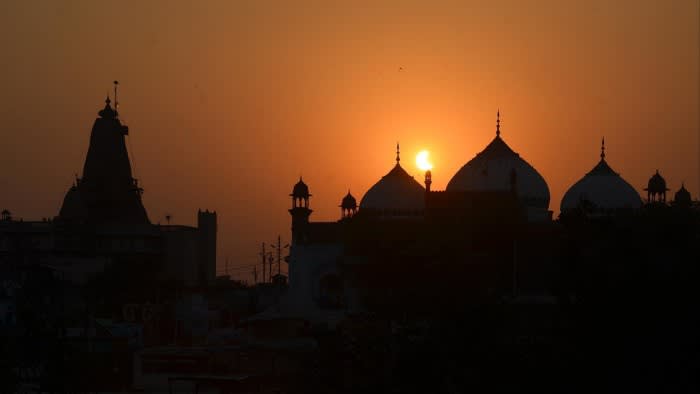Shortly after midnight on February 1, Hindu worshippers entered the grotto-like cellar of Gyanvapi mosque in Varanasi, northern India, and held prayers for the first time in more than three decades. Hours earlier, a district court had approved a legal petition by Hindus to allow the acts of devotion to go ahead.
The mosque was built in the 17th century by Emperor Aurangzeb. Hindu nationalists have long contended that a temple devoted to the god Shiva at the site was demolished by India’s then-ruling Mughals, who were Muslim. Today Hindus and Muslims worship in proximity; an alley just a few feet wide separates the mosque from the Kashi Vishwanath Hindu temple, built in its latest version in 1780.
The complex, inside a high-security compound, is patrolled by brooding armed soldiers and police. It is one of the world’s tensest shared religious sites outside the Middle East, where Palestinian Muslims and Israeli Jews pray in proximity at Jerusalem’s al-Aqsa mosque and the Western Wall.
Now Gyanvapi is at the centre of an emotive legal campaign by Hindu nationalists. Their aim is to reclaim physical space for worship at sites where India’s Muslim dynasties razed temples and built mosques. How it plays out will shape religious discourse, social equanimity and the direction of secular democracy in the world’s most populous country.
Hindu revivalism, of which the temple “reclamation” movement is part, will play a key role in India’s upcoming national election, which will be held between April 19 and June 1.
Narendra Modi’s Bharatiya Janata party is widely expected to vanquish India’s divided opposition led by the Indian National Congress and win a third five-year term.
In January, Modi presided over the consecration of a vast new temple on the site of the 16th-century Babri mosque in Ayodhya, thought to have been built atop the ruins of an older Hindu temple. The mosque was torn down by religious zealots in 1992, in what is now seen as a defining moment for the BJP’s Hindu nationalist politics.
Now two other major sites of shared worship are in nationalists’ sights, raising the spectre of further, profound communal disputes surfacing elsewhere in India along the country’s main religious divide.
Hindu litigants are mounting court challenges to have centuries-old mosques torn down both in Varanasi — home to the Kashi Vishwanath complex — and in the northern city of Mathura, revered by Hindus as Lord Krishna’s birthplace.
For Hindu nationalists, the claims are part of a project to restore the religion to which four-fifths of India’s 1.4bn population adhere to its rightful place of supremacy — and to “decolonise” a country shaped, and in their view marred, by first Muslim and then British domination.
“These disputes which we are fighting are for a cultural restoration and renaissance,” says Vishnu Shankar Jain, an advocate representing Hindu litigants in the cases in Varanasi and Mathura. “It’s a dispute for the restoration of our heritage, of our glorious cultural past, and for the restoration of the rights of our deities.”
But for many of India’s roughly 200mn Muslims, the wrangling over shared religious spaces are an intrusion on their rights by a government they see as promoting Hinduism above other religions, and one that is bent on wiping Mughal heritage and other non-Hindu elements from history books.
It has been accompanied this year by the razing of two mosques, one in Delhi and the other in India’s northern Uttarakhand state, on the grounds that they represented illegal “encroachment”. The Delhi mosque was six centuries old.
The disputes over archaeology, historic legitimacy and religious rituals sit at the heart of a broader discussion about India’s multicultural nature and constitutional rights under the rule of a prime minister and ruling party who embrace Hindu supremacy.
“This is an instrument for inflaming emotions, passions — a way of polarising divisions,” says Zoya Hasan, professor emerita of history at Jawaharlal Nehru University in Delhi. “It’s a Hindu-Muslim dispute, and they want to keep the issue alive to consolidate the majority Hindu vote and very importantly to show Muslims their place.”
Little understood outside India, efforts to reclaim Hindu religious sites destroyed by Muslim rulers have gone on for decades. The current legal struggle by Hindu and Muslim petitioners is an emotionally charged one in which deities are invoked by politicians and, in some cases, are parties to legal petitions.
The Varanasi court gave Hindu petitioners the right to pray in Gyanvapi’s cellar after a controversial government archaeological survey under the mosque found broken idols, regarded as proof a temple once existed on the site. Hindu worshippers had believed this to be the case for centuries, and an idol of Lord Shiva’s bull Nandi faces across the alley towards Gyanvapi’s cellar for this reason. (Muslims say the area housed a fountain used by worshippers for ablutions.)

“It was like a dream,” says Shailendra Kumar Pathak Vyas, a pujari or Hindu priest, who claims his family has been responsible for prayers at the site for centuries. “Not only did the court judgment come, we were told to just come and the puja [worship] will start.” News that the steel grate barring the cellar entrance had been removed spread “like wildfire” via WhatsApp messages, he says, and Hindu devotees flocked into the cellar from the adjacent temple, taking photos.
Across town, in Varanasi’s densely populated Muslim neighbourhood of Azad Park, news that Hindu prayers were commencing in the mosque’s basement stirred fears that the building’s future was now in peril.
“It was frightening,” says Abdul Batin Nomani, the mosque’s imam. “There was an atmosphere of fear and everybody was disturbed throughout the night.” An advocate representing the Muslims, Fuzail Ahmad Ayyubi, filed an urgent supreme court petition in the small hours.
In the week that followed, the Muslims’ fears appeared to be confirmed. Varanasi, like Ayodhya and Mathura, is in Uttar Pradesh, India’s most populous state and the BJP’s heartland. Yogi Adithyanath, a Hindu holy man who is sometimes tipped as a Modi successor, is the state’s chief minister.

Speaking at the state assembly in Lucknow days later, in a show of support for reclaiming the site couched in religious language, Adithyanath said that it was Shiva’s bull who had “got the barricading broken overnight” at Gyanvapi mosque.
Hindu revivalism was given a shot in the arm in 2019, when India’s Supreme Court allowed the building of the temple in Ayodhya to go ahead, 27 years after the Babri mosque was destroyed. The ruling followed a long legal struggle by Hindu nationalists and an archaeological survey.
Archaeological evidence and British imperial accounts support their claims that India’s Muslim rulers razed temples to build their grand domed structures in places like Kashi (the Hindu name for Varanasi) and Mathura. Hindus rebuilt their temples alongside them, and generations of Hindus like the Vyas family in Varanasi continued to pray at the old sites, such as in Gyanvapi’s south cellar.
“[Hindus] never forgot the sites, and kept up the struggle to get hold of the site,” says Meenakshi Jain, a former professor of history at Delhi University’s Gargi college, and an author of books about Kashi and Mathura, who is no relation to the lawyer. “If they couldn’t get hold of the site, they got as close as possible.”
But for many Indian Muslims and secular liberals, the issue is not about which community got there first, but protecting minority religious rights and a status quo on worship enshrined in Indian law.
In 1991, under a Congress-led government, India passed the Places of Worship Act, which in effect halted such disputes (except in Ayodhya) by freezing religious sites’ status as it stood in August 1947, when India won independence.

The act was passed amid tensions over Ayodhya’s Babri mosque, which was destroyed the following year, leading to deadly religious rioting in 1993 that killed at least 1,000 people in Mumbai and elsewhere. A former Uttar Pradesh state government led by the regional Samajwadi party, which BJP supporters regarded as pandering to Muslim voters, prohibited Hindus from offering pujas in Gyanvapi’s cellar in 1993.
The temple movement has gained momentum since the BJP took power nationally in 2014, and accelerated since the 2019 supreme court decision on Ayodhya. Hindu petitioners have filed a slew of civil cases for surveys in Varanasi’s Gyanvapi mosque and in Mathura, where the litigants are seeking to have a Hindu-Muslim agreement on the shared complex overturned.
“There is a template and the template is clear: Hindutva [Hindu nationalist] groups make claims to a mosque, claiming there are temple remains behind it,” says Hasan, the academic. “They ask the court to order an archaeological survey, and they almost invariably find — which is not a surprise — that there are some temple remains.”
This, however, is a “legal figleaf”, she asserts. “When an archaeological survey is conducted and temple remains are found, the next step is to lay claim to the site.”
Whereas a mob tore down the Babri mosque, no such violence is now required, analysts say. In Modi’s India, Hindu nationalists believe that they have not just history but a sympathetic government and the courts on their side.
In Varanasi and in Mathura, Jain, the lawyer, and his father Hari Shankar Jain have led the fight by Hindu litigants to restore Hindu worship at the site of mosques.
In Varanasi the pair were legal advisers on seven civil suits in 2020-21 calling for the Gyanvapi mosque to be removed and similar civil suits calling for the removal of the Shahi Idgah mosque in Mathura in 2022.
“We want the removal of these mosques,” the younger Jain says in his office in Ghaziabad outside Delhi, where the door is decorated with Hindu religious symbols. “Our legal case before the court is that this is the site of a Hindu temple that has been wrongly converted or wrongly used as a mosque.”
The petition seeking to allow Hindus to pray in the cellar under Gyanvapi was brought by the Vyas family. Separately, five Hindu women with links to nationalist circles have filed a petition to be allowed to offer prayers inside the Gyanvapi mosque complex. Jain says he is working independently: “We are individuals who are working on this issue and we are not affiliated or associated with the ruling party.”
Lawyers representing Muslims in Varanasi are trying to fight back in court.

“It’s very surprising that in 2023-4, when we are moving ahead with economic development and technology — to move forward with such things is surprising and painful,” says Ayyubi, who has represented Muslim litigants in both Gyanvapi and Mathura. “For almost 400 years, the mosque has been there.”
While the legal dispute around Ayodhya dragged on for decades, things appear to be moving quickly now. After the decision to allow Hindus to pray in the Gyanvapi cellar was handed down in the evening of January 31, devotees were there saying prayers within hours, giving Muslims no time to appeal against the decision.
“On Babri, they gave all sides enough time,” Ayyubi says. “This time it’s being rushed through — there is unusual haste.”
At the complex one recent evening, Gulshan Kapoor, president of a committee set up to “liberate” a Hindu shrine located at Gyanvapi’s back wall, pointed to what he said were remnants of Hindu temple architecture along the mosque’s perimeter. “All the walls are still [Hindu] temple walls,” he says.
Kapoor’s group has published a pamphlet about the site, which includes an artist’s rendition of a future temple. When asked what he thinks should happen at the site, he replies: “I have no hesitation in saying that the mosque will have to go to build our temple.”
In the centre of Mathura, the 17th-century Shahi Idgah mosque sits within the Krishna Janmasthan Hindu temple compound. Hindus believe Lord Krishna was born here in a prison cell. Under an agreement reached in 1968, Hindus and Muslims pray in separate designated areas.
Security forces patrol the site, and visitors entering are required to check digital devices, bags, and other belongings — including on one recent day a notebook and a pen because, in the words of a guard, “you might try to draw a map”.
Hindu litigants are seeking to have the mosque declared null and void in a lawsuit filed on behalf of a god, Lord Krishna, a practice with a long history in Indian law. “We have the proper evidence to prove that this property belongs to Lord Krishna,” says Mahendra Pratap Singh, a Hindu litigant who registered the first case.
When asked what his side would do if they were to prevail in their lawsuit, he says: “Build a temple.”
“These things only started in 2020, when outsiders came and filed a petition,” says Tanveer Ahmed, a lawyer representing the Muslims who are seeking protection from any change at the site under the Places of Worship Act. Ahmed links the court challenge to the 2019 court ruling allowing the Ayodhya temple to be built. “The issue started only when they were done in Ayodhya, and they turned their gaze to this one,” he says.
In recent remarks, members of Modi’s government have described January’s temple opening in Ayodhya as the “start of a new era”. India’s BJP-dominated lower house passed a resolution praising the temple opening; Modi’s powerful interior minister Amit Shah said that January 22, when the temple opened, was set to be recognised as “a historic day for 10,000 years”.
If Modi and the BJP succeed in their goal of winning a third term with a commanding majority, Indian liberals fear it will provide further fuel to the nationalists’ campaign to “reclaim” shared Hindu-Muslim religious sites.
Inside Mathura’s mosque-temple compound, a security guard muses on the need for religious harmony. “Indians don’t know their fundamental rights. Everybody has the right to their own religion, to worship the way they want, and it’s the government’s duty to ensure the right to worship,” she says. But on a regular basis, she adds, “people come through and ask me, ‘oh, when is that thing [the mosque] going to be torn down?’”





























